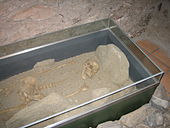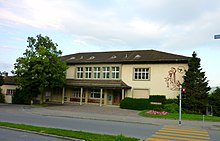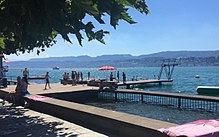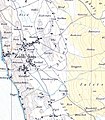Zollikon
| Zollikon | |
|---|---|
| State : |
|
| Canton : |
|
| District : | miles |
| BFS no. : | 0161 |
| Postal code : | 8702 Zollikon 8125 Zollikerberg |
| Coordinates : | 686 126 / 244141 |
| Height : | 482 m above sea level M. |
| Height range : | 405–691 m above sea level M. |
| Area : | 7.85 km² |
| Residents: | 13,012 (December 31, 2018) |
| Population density : | 1658 inhabitants per km² |
|
Proportion of foreigners : (residents without citizenship ) |
23.9% |
| Unemployment rate : | 2.2% |
| Mayor : | Sascha Ullmann ( GLP ) |
| Website: | www.zollikon.ch |
| Location of the municipality | |
Zollikon ( Zurich German Zolike [ˈtsolikχə] ) is a municipality in the Swiss canton of Zurich . It is located on the northeastern shore of Lake Zurich on the so-called Gold Coast in the Meilen district (until 1986 Zollikon was part of the Zurich district ). The Zollikerberg also belongs to the community .
The community is commonly counted among the wealthier suburbs of Zurich.
geography
location
The municipality of Zollikon extends in a strip around two kilometers wide and five kilometers long from west to east from Lake Zurich up the flank of the Pfannenstiel up to the Breitmoos on the border with Maur. The lowest point is on the lake at a height of 408 meters, the highest at a height of 662 meters near Breitmoos.
The parts of the village of Zollikerberg and Zollikon-Dorf are separated from each other by a forest belt. The Allmend lies on a terrace below the forest .
The neighboring communities of Zollikon are the city of Zurich in the north, Maur in the east, Zumikon in the southeast and Küsnacht in the south. The municipal area is 785 hectares, of which 36% are forest, 33% settlements and 12% agricultural area.
Forest
A wide forest belt stretches across the municipality of Zollikon from Zurich to Küsnacht. With 280 hectares, the forest area makes up more than a third of the municipal area; In terms of percentage, Zollikon is one of the more densely wooded communities in the canton.
On April 30, 1330, the approximately 250 residents of Zollikon joined forces to form the timber corporation, which regulated the use of the forest and prevented its sale to outsiders. The timber regulations formed the basis for the village regulations drawn up in 1572, in which the statutes and customs applicable in Zollikon were recorded. In 1798, after the end of the old Swiss Confederation, the corporation became a private company.
Most of the Zolliker forest is now owned by the timber corporation. Other owners are the old citizens' association Zollikon, the municipality and some private individuals.
Waters
The longest stream in the village is the Salsterbach. It rises in two arms in the forest between mountain and village and forms the border to Küsnacht in the inhabited area as Düggelbach . In the north, the Nebelbach forms the border with the city of Zurich. It flows through the pond of the same name.
In the Zollikerberg, the Wehrenbach forms the boundaries to the city of Zurich over long stretches . The Rossweidbach flows into the Wehrenbach from Maur and the Stumpbach flows from the Rüterwies. The Brunnenbächli, which flowed along Forchstrasse from Zumikon , was almost completely filled in. Only the street name Weiherweg is reminiscent of a pond in the Rietholz district. The lake in Zollikon is almost 1.5 kilometers.
Names
The first written mention of de Collinchovin is derived from Old High German [bī dien] Zollingo hovum and therefore means "at the yards of the Zollinger" or "at the yards of the people (clan) of the Zollo". The name contains the affiliation expressive derivative syllable -ing .
Spellings for Zollikon: 946: Collinchovin, 1145: Zollinchoven, 1209/33: Zollinchon, 1223: Zollicon, 1504: Zolliken .
Spellings for Trichtenh (a) usen: 946: Truhtilhusa, 1230: Truchtenhusen, 1362: Trüchtenhusen, 1504: Trichtenhusen, in the 15th century also Drüchtenhusen .
Spellings for Witellikon: 946: Witalinchova, 1153: Wittalinchoven, 1158: Witalinchon, 1250: Witelinchon, 1261: Witelinkon, 1313: Wittelikon, 1667: Wyttellicken .
history
First tracks
The oldest find on Zolliker Boden dates from the Neolithic : In 1972 a small stone ax was found in Chleidorf, which is believed to have come from the Pfyner or Horgen cultures . However, it is a single find; Neolithic settlements on Zolliker soil are not proven.
Neither are there any evidence of settlement sites from the Bronze Age , but it can be assumed that people lived in Zollikon at that time. It is conceivable that the remains of the settlement (stones, coal remains and piles) found in the Breitmoos area in 1913 date from the Bronze Age; Many lakeside settlements were given up in favor of rural settlements at that time.
First settlement
The first traces of settlement in the municipality come from the Hallstatt period . At that time five burial mounds were built on the Feufbüel , which are still clearly recognizable today and are called Celtic graves .
In 1968 an iron sword from the Latène period was found in the Oberhub in Zollikerberg . Traces of oxidation suggest a cremation grave , of which, however, no traces remained. Even if there are no traces of settlements, it can be assumed that there were individual farms in the Zollikerberg.
In 1962, during excavation work in the Unterhueb in Zollikerberg, a field of eleven stone box graves from the 8th and 9th centuries, facing east to west, came to light. The last burial was the well-preserved skeleton of a 50-year-old man. The arrangement of the graves in sandstone slabs and chunks and their distribution suggest a small high medieval burial place, which has been used over and over again for a long time, the main group of which was once in the area of the Sennhofweg, perhaps a little further south, where possibly the one that has been since 1275 The "Chapel of Trichterhausen" was mentioned again but never found.
The two still existing field names Deisten (Dingstatt, court) and Galgenbühl (place of execution) indicate a special meaning of the Zollikerberg. Apparently there was an ecclesiastical and judicial center there, which should go back to the 8th and early 7th centuries.
First written mention
The first written mention of Zollikon comes from the year 946: On April 28, it is recorded in a Latin document that Zollikon ( de duabus Collinchovin ), Trichtenhusen ( Truhtilhusa ) and Witellikon ( Witalinchova ) have to pay the church tax to the Propstei Grossmünster . Thus the tithe right encompassed the entire area of today's municipality. The expression de duabus Collinchovin - the two Zollikon - probably refers to the first two guards in the village, Chleidorf and Hinterdorf / Oberdorf.
In 1223, Dietericus, a Dietrich from Zollikon, appears for the first time in a document from the monastery on Zürichberg as a witness, presumably a fiefdom of the Barons von Regensberg . The wealthy family from Zollikon is mentioned as early as 1145. Presumably their seat was above the Gugger at the upper edge of the Golden Halde near today's Letzistrasse, where a Letzi was used to protect him. The Golden Halde was the most important Zollikon vineyard until the beginning of the 20th century. The facility was also protected by the Düggelbach ravine and was able to control the traffic on the Alte Landstrasse.
At that time, Zollikon was part of the Imperial Bailiwick of Zurich, which was divided up as the last owners of the Bailiwick after the Zähringer died out : The area from Stadelhofen to Meilen fell to the Regensbergers, who sat on the Friedberg castles in Meilen and Wulp above Küsnacht . Often people from Zollikon appear in their wake.
After the decline of Regensberger the "von Zollikon" moved with their masters after the then rain mountains innovative Grüningen , where they settled as 1279 in the Habsburg Urbar is held: ussidelinge, de ze Zollinkon sint sat .
The Vogtei over Zollikon came to the Mülner family , who presumably owned the Meierhof von Stadelhofen and already had rights to Zollikon. It is not known exactly when the transition took place, but on October 20, 1333 Götz I. Mülner had the possession of the imperial fiefs of Emperor Ludwig the Bavarian confirmed: the vesten manne Gottfriden dem Müllner, our dear loyal loyal . In 1358 his son Götz II. Mülner sold the rights for 400 silver marks to the city of Zurich, which they shared from then on. This made Zollikon the first area outside the city of what would later become the Canton of Zurich.
Bailiwick
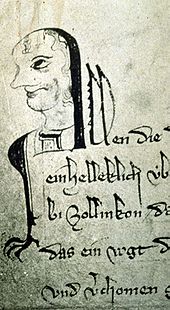
In 1384 Zollikon became part of the Obervogtei Küsnacht, which was administered by two senior bailiffs belonging to the Zurich council. Their representative in the community was the sub-bailiff, who supervised and presided over the twelve jurors, the actual community council. This affiliation lasted until 1798.
On April 30, 1330, still at the time of the Mülner , the approximately 250 inhabitants of Zollikon organized themselves with the establishment of the wood corporation in a village cooperative, which regulated the use of the forest. In order to give the document legal force, the customs officers asked Reichsvogt Mülner for confirmation and a seal. At a time when only the cities of Zurich and Winterthur appeared as legal entities, this was a remarkably self-confident act. Zollikon thus became the canton's first self-administered municipality.
Over time, the board of the wood corporation was given other tasks in the community. The timber regulations formed the basis for the village regulations drawn up in 1572, in which the statutes and customs applicable in Zollikon were recorded. In 1798, after the end of the old Swiss Confederation, the corporation became a private company. The timber corporation still exists today.
population
A large part of the population at that time were servants of the Mülner, the Grossmünsterstifts Zurich or the monasteries Einsiedeln and St. Gallen . The serfs had to pay a small tax, but otherwise occupied a position similar to that of the free peasants. The last known serf in Zollikon was Verena Frick in 1391 as a slave of Hans von Hohenlandenberg . Later the obligations to the host were replaced or were forgotten. At least since the 15th century, the residents of Zollikon can be seen as free.
Reformation time
During the Reformation, Zollikon was the starting point for the Anabaptist movement . On the evening of January 21, 1525, the baptism of believers was donated for the first time in a private house in Zurich . Fear of persecution by the City Council of Zurich, which had previously ordered the forced baptism of infants in the dispute with the Anabaptists, the baptized fled to Zollikon. As a result of Jörg Blaurock's sermon, a great revival movement arose within a few days, which reached people of all walks of life. Other actors were Felix Manz , Konrad Grebel and Johannes Brötli . Many wanted baptism. They gathered "back and forth in the houses" according to the early Christian pattern. The fathers of the house read the New Testament texts from the Lord's Supper and offered bread and wine to those present. These gatherings can be seen as the first Protestant communion celebrations in the Zurich area, as evangelical preaching in the churches of Zurich until Easter 1525, but the communion was still celebrated according to the Roman Catholic rite. A plaque at Gstadstrasse 25 commemorates one of the first Anabaptist meetings in Zollikon.
After the secularization of the monasteries during the Reformation , their assets and property fell to the Zurich council, and from then on the tithe had to be paid to the city. In community matters, the city granted the subject areas extensive autonomy, but not in economic terms: Due to the monopoly of the city's guilds , crafts and trades were of minor importance in Zollikon. The town's refusal to free the peasant from medieval obligations such as tithing led to increasing tensions that only ended with the overthrow of the old order.
The new order

In February 1798, Zurich had to declare the equality of town and country , the old Zurich government resigned and handed over power to a "country commission", the uniform constitution of Helvetic Republic replaced the old order. An agent, who later became the mayor, took the place of the subordinate. The municipality's administrative authority was a municipal council, the so-called municipality, headed by a president, and the political municipalities emerged. The Zollikerberg was initially assigned to Zumikon , but decided in 1803 in a vote with 48 to 8 votes in favor of belonging to Zollikon. Zollikon and Zollikerberg have formed the political municipality of Zollikon since 1804. An incorporation into the city of Zurich was rejected in 1929.
coat of arms
- Divided diagonally by blue and silver, a gold star above, a red diagonal bar below.
The Zolliker coat of arms has been in effect since the cantonal coat of arms regulation of February 1930. In its current form, it was first mentioned in 1493 in Gerold Edlibach's register of arms . It was Edlibach who replaced the red bird originally featured in the coat of arms with a red sloping bar. An earlier form of the coat of arms shows an inclined key, which probably referred to Simon Peter , the patron saint of the new Reformed Church.
Population development
The resident population of Zollikon has increased more than sixfold since 1900: At that time Zollikon had almost 2000 inhabitants, today the number is around 12,800. Population development:
| year | 1467 | 1640 | 1702 | 1799 | 1860 | 1900 | 1920 | 1930 | 1941 | 1950 | 1960 | 1970 | 1980 | 1988 | 2000 | 2008 | 2014 | 2015 | 2016 |
| Residents village | ~ 250 | 457 | 566 | 709 | 1093 | 1571 | 2554 | 3851 | 4695 | 5216 | 6665 | 7088 | 7194 | 6908 | |||||
| Inhabitant mountain | ~ 30 | 53 | 67 | 181 | 360 | 312 | 450 | 625 | 1194 | 1674 | 3366 | 5276 | 5275 | 4829 | |||||
| Total population | ~ 280 | 510 | 633 | 890 | 1433 | 1883 | 3004 | 4476 | 5889 | 6890 | 10'031 | 12,364 | 12,469 | 11,737 | 11'491 | 12,113 | 12,500 | 12,726 | 12,776 |
The proportion of foreigners was 24% in 2016. The majority of the population is reformed. In Zollikon, 23.7% of the population is over 65 years old; 20% of the population are children and adolescents (0-19 years).
Settlement development

The first mentioned settlements in the village are the Chleidorf and the upper and rear villages. With the construction of a first chapel, a third settlement center was probably created near Chirchhof in the 9th century. The youngest of the four old guards, the Gstad, grew gradually from the lake up the hill. The old settlement centers are still largely intact today. One of the oldest houses is the Haus Im Felsengrund from 1528 in the upper village, which is now used as a local museum. There were also three individual houses on the lake: Tolen, the Gugger and the Trubenberg . The "Trubenberg" was built in 1599 as a lake-side extension to the farm "In der Hell" (= hell, which means "deeply located locality") mentioned in 1466. The house was home to three Zurich mayors from the Escher family .
The legal equality of the rural and urban populations and the associated abolition of medieval fiefdoms led to an economic boom at the beginning of the 19th century. Land became freely available property, which was the prerequisite for the development of building land. However, the greatest impact on population growth was the introduction of freedom of establishment.
With the first city expansion in 1893, Zollikon became a direct neighbor of the city. Due to the traffic development, such as the opening of the right bank of the Zürichseebahn and the spacious construction of streets, Zollikon became the preferred place of residence for wealthy townspeople. In 1836 there were 122 houses with 260 apartments in Zollikon, in 1966 there were 1667 houses with 4029 apartments. This is how the quiet wine-growing village became a city-oriented agglomeration community within a few decades.
politics
The mayor is Sascha Ullmann ( GLP ). Further municipal council members for the 2018 to 2022 term of office are Bernhard Ecklin (SVP), Urs Fellmann (FDP), Martin Hirs (SVP), Corinne Hoss (FDP), André Müller (FDP) and Sylvie Sieger (FDP).
In the 2019 National Council elections, the share of the vote in Zollikon was: FDP 31.4%, SVP 22.1%, glp 16.5%, SP 11.9%, Greens 9.6%, CVP 3.8%, EPP 1.9 %.
societies
The club cartel was founded in Zollikon in 1961. The association cartel represents the interests of many village associations as an umbrella organization. Associations that are based in the municipality of Zollikon can join. The association cartel organizes events such as the Dreikönigsapéro and coordinates the collection of waste paper, among other things. 48 clubs belong to the club cartel.
economy
Viticulture
The farmers in the village were primarily engaged in growing vines. It was their main source of income and established their prosperity. The wine-growing was introduced by the Romans in our area, has benefited from excellent climatic and topographical conditions and intensively on the right bank of Lake Zurich since the early Middle Ages. In 1626 the vineyards in Zollikon comprised around 60 hectares, of which around 48 were owned by 50 Zolliker farmers. The rest belonged to townspeople or were church property. In 1808 there were still 42 ha in which 107 farmers shared. In 1885 there were still 58 hectares of vineyards. 40 trotters were once in operation in Zollikon. The last one was in the Gugger and was in operation until 1912.
Diseases, increased wine imports and, above all, the enormous increase in demand for building land led to almost all vineyards being built over in the course of the 20th century. Today there are two larger vineyards in Zollikon on 28 ares, from which the local white wine "Lunggesüder" has been made from Riesling-Sylvaner grapes since 1961 . The wine cannot be bought; it is served by the community on special occasions.
Fruit growing
As the demand for table and cider fruit increased in the 17th century, fruit growing became more important. In the area of today's cemetery, the fruit-allmend was laid out, in which every founder of their own household and every new citizen had to plant a tree. In the middle of the 19th century, the meadows were pushed back in favor of arable farming; at the same time, each farm owner planted his own orchard. The proceeds were auctioned on Chilbimontag in favor of the community. The last fruit gant took place in 1925. At the end of the 19th century there were 65 different apple varieties and about as many pear varieties. Nuts were also grown, the oil of which was in great demand. Today the former orchards are almost completely built over.
Livestock and agriculture
In addition, grain and, since 1760, potatoes were grown for self-sufficiency. Cultivated in three-field farming until about the middle of the 18th century , then the fallow land was dissolved and also planted. Cattle breeding was also practiced, especially in the Zollikerberg, where arable farming was more important than in the village. Excess milk was sold to Zurich.
Home work
Home work was mainly done by women and daughters from poor families and was already widespread in the 17th century. Flax and hemp were spun . The house industry collapsed through industrialization , but silk weaving developed from 1830 onwards . In 1870 there were 149 silk looms in the village, 89 in the mountain, so two in each household. In winter, men also increasingly worked in the weaving mill, they worked heavy fabrics such as brocade and velvet . With the increased use of mechanical looms, domestic silk weaving also came to a standstill and the few silk manufacturers disappeared.
traffic
Streets
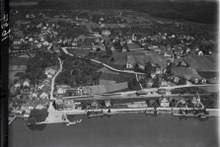
Until the middle of the 19th century, the Alte Landstrasse (also known as “Heerweg”) was the only longitudinal connection in Zollikon. It was probably built halfway up in Roman times. The old Forchstrasse (also known as “Grüninger Strasse”) led over the Zollikerberg, which at that time took a different route past the Sonnengarten restaurant over the Unterheb to the Chaltenstein and on to the Forch . The connection within the community was made up of narrow paths and cart paths.
In 1833 a "law on roads" came into force, which made expropriations possible and gave the canton an effective means of promoting road construction. In 1838 the construction of the Seestrasse began; the previous riverside path was widened with embankments and retaining walls. In 1839 the section on Zolliker Boden could be used; the whole route to Rapperswil was completed in 1844. In the middle of the 20th century it was paved and widened again. The new Forchstrasse was built in 1843 with a completely new layout.
The heavy building activity towards the end of the 19th century required the roads to be expanded; There were hardly any roads, especially in the cross-connection. At the municipal assembly on August 30, 1885, the decision was made to build Zolliker Strasse, which was also intended to open up building land. A road construction concept was adopted in a development plan in 1894 after the government council rejected an initial project that had provided for a dense road network a year earlier. Dufourstrasse was built in 1897, Bahnhofstrasse in 1898, Höhestrasse in 1906 and Guggerstrasse in 1908. In a second stage between 1925 and 1935 the Goldhaldenstrasse, Bergstrasse, Schlossbergstrasse and Rotfluhstrasse as well as other district streets were built.
In 1961, the government council approved the alignment of a right bank Höhestrasse, which should relieve the other streets. Zollikon should be bypassed in a tunnel due to a resolution of the municipal assembly. However, the project was never carried out. Today, Tempo 30 applies on all neighborhood streets in the entire municipality.
Public transport
On May 21, 1929, a bus company started operating in the village. The buses serve to connect with the neighboring communities. The tram line 11 and bus lines of the Zurich public transport service serve the districts close to the city.
On March 14, 1894, the right bank of the Zürichseebahn was opened; in May 1926 it was electrified. Today the lines S6 and S16 of the S-Bahn Zurich stop in Zollikon .
Shipping has always been of great importance in Zollikon. Until the end of the 19th century, most of the transport of goods and people took place across the lake, such as goods transport to the city or to the Bündnerland and Gotthard or pilgrimages to Einsiedeln . Zollikon owned a community or market ship that was operated by an employed skipper and transported goods and people to Zurich, especially on market days. With the advent of road and rail traffic, the waterway lost its importance. Today several ZSG scheduled ships operate daily from Zollikon.
Attractions
- Celtic graves in Zollikon
- Local museum in the Haus Im Felsengrund
- Park of the Villa Meier-Severini with iron sculptures from the Foundation for Iron Plastic Collection Dr. Hans Koenig (hereinafter referred to as the Dr. Koenig Collection )
In Zollikon's public space there are numerous sculptures by artists such as Carlo Vivarelli , Otto Münch , James Licini , Günter Gianni Piontek, Silvio Mattioli , Georg Kolbe and others.
Bernhard Luginbühl : Danielstengel
Bull at the boat station: sculpture by Franz Fischer
Carlo Vivarelli : Four concave and four convex corners, Oescher school complex
Yasuo Mizui : Key to Heaven; Bergstrasse / Forchstrasse
Stahlbau 400 by James Licini
Churches
Reformed Church Village
The Reformed Church of Zollikons was built between 1497 and 1499.
Catholic church village
On October 2, 1927, for the first time since the Reformation, a Catholic service was held in what was then the “Bellevue” hotel on Dufourplatz; the Catholics had previously visited the church in Zurich or in Küsnacht. In 1929/1930 a Catholic church was built on Riethofstrasse, which was consecrated on Easter Monday, April 6, 1931.
In June 1982 the parish assembly decided to build a new church. Because there was no agreement, the project by the architects Caretta & Kupferschmid was not approved until 1994. The foundation stone was laid on September 15, 1996, and the bells were raised on the new church tower on May 24, 1997. The church was dedicated on June 29th.
school
The origin of the school system in Zollikon goes back to the year 1525, when the schoolmaster Peter Forster is mentioned in connection with an Anabaptist trial . The schoolmaster Hieremias Schumacher and his son Fridli are mentioned in baptismal books between 1560 and 1595; in 1620 a Jacob Esslinger appears; Schoolmaster at Zollickon . The Zolliker school system took off in 1634 when Hans Jakob Murer (1611–1681) taught the Zolliker youth reading, writing and Christian singing on the basis of the first Zurich school law. Lessons took place with up to 40 children in Murer's own living room at Oberdorfstrasse 21/23. The school was not held in high esteem and attending classes was based on the parents' needs. The teacher's salary was so inadequate that he had to work on the side. Until 1760 the office of schoolmaster was in the hands of the Murer family.
The summer school introduced by Murer was abolished in 1643 and lessons continued in the winter months; only towards the end of the 17th century was a school opened in summer and winter. The school came to a standstill , which also made the periodic election of the teacher.
In 1717 the standstill bought a house on Sägegasse in Chleidorf and set up a simple schoolroom in it. For 110 years the building served the Zolliker schoolmasters as a living and teaching facility. Up to 60 children sat in the narrow room in summer and winter. The windows were only opened once a day to save heating costs. Every now and then the teacher would smoke out the room with juniper to drive away the worst smells. Classes lasted from 8 a.m. to 11 a.m. and from 1 p.m. to 4 p.m. three weeks and Martini Day (November 11th) were free of school.
Hans Jakob Murer, who died in 1760, was followed by Hans Konrad Bleuler (1724–1784) and later until 1856 his sons. In 1783 Jakob Bleuler was given his own living space, from then on the schoolroom was only used for teaching. With the new School Act of 1778, school instruction became compulsory. After 1799, the Zollikon school district also included the children from Zollikerberg. As the number of students increased steadily - in 1822 Heinrich Bleuler taught 114 everyday students and 93 repeat students in the upper level - the Chirchhof school was built in 1829 for 11,000 guilders. The new building was moved into in spring 1830.
Around 1850, school gymnastics began in Zollikon and for this purpose a gymnasium 15 meters long and 5 meters wide was built. In 1880 the square was enlarged. Handicraft and swimming lessons were also introduced towards the end of the 19th century.
The four classrooms in the Chirchhof soon no longer met the requirements, rooms had to be rented from private individuals for lessons. In 1900, the new schoolhouse was built on the Buchholzhügel according to plans by architects Kehrer & Knell and inaugurated in 1901. Primary and secondary schools were housed in it. At the same time, the gym with the characteristic hose tower of the fire brigade was built, which existed until 1970.
From 1905 to 1937 the number of pupils rose from 294 to 403 as a result of the construction work in Zollikon. In 1937, the new primary school building designed by the architect Jean Kräher "Buechholz" with eight classrooms and side rooms was inaugurated. In 1953 the name was changed to "Oescher" in connection with the construction of the new wing B with four new rooms, a singing hall and a gym. The name «Buechholz» was transferred to the new upper school building, which was built in 1972 on the site of the old secondary school building on the hill.
A replacement of the 50-year-old Oescher B in need of renovation was preferred to renovation in 2002, also due to the increased space requirement including day-to-day structures. In 2004, the project “Room with a view” by the Zurich architects Regula Harder and Jürg Spreyermann in collaboration with the landscape architect Martin Klauser was unanimously awarded first place by the jury. On September 24, 2006, the population approved the construction project. Construction work began in summer 2007. In autumn 2009, the new school building and the care center were occupied and officially opened in March 2010. The costs for the building and work on the surrounding area amounted to around CHF 27 million.
Holiday home «Höchi»
The “Höchi” holiday home in Wildhaus SG belongs to the Zollikon school and can be used for class and holiday camps. It is not only available to the Zolliker School, but can also be rented by private or foreign schools. The former farmhouse was converted into a warehouse in 1926 by the Zolliker architect Hermann Fietz (1898–1977) and has been owned by the Zollikon School since 1929. Showers were installed in the late 1940s and central heating was added in 1966. In 1978/79 the old middle section with the two stairwells was torn out and rebuilt. It was last extensively renovated in 1997.
leisure
There are numerous options for recreational activities such as the indoor and outdoor swimming pool in Fohrbach, the seaside pool, the Riet sports field, two scout departments, a youth center, leisure service, football club and other sports clubs.
Zollikon on old maps
Zollikon on the Gyger map from 1667
Zollikommer ban from 1720
Zollikon on the Wild map from 1848
Zollikon on the Siegfried map from 1881
this and that
- In August 2019, Zollikon was voted the most attractive municipality in Switzerland by Die Weltwoche magazine .
- At the Zurich Knabenschiessen 2019, the Zolliker Neva Menzi was the shooter queen with 35 points.
- In 1947, the Zolliker teacher and composer Jakob “Schaaggi” Spörri (1886–1965) set the poem by Emilie Locher-Werling Abiglüte am Zürisee (“ Evening Sounds on Lake Zurich ”) to music .
Personalities
- Artur Beul (1915-2010), composer
- Vincenzo Biagi (born 1932), actor
- Eugen Bleuler (1857–1939), psychiatrist
- Zvonimir Boban (* 1968), Fifa General Secretary; lives in Zollikon
- Paul Bodmer (1886–1983), painter; had his studio in Zollikerberg
- Fritz Boscovits (1871–1965), painter and caricaturist
- Ulrich Bremi (* 1929), entrepreneur and politician (FDP); lives in Zollikon
- Robert Dubs (1880–1963), engineer
- Arthur Frey (1897–1955), church politician, lived in Zollikon
- Ulrich Knellwolf (* 1942), crime writer and pastor
- Heinrich Bruppacher (1845–1906), philologist
- Bruno Giacometti (1907–2012), architect
- Ludwig Hasler (* 1944), philosopher and publicist
- Reto Hänny (* 1947), writer
- Dinah Hinz (1934-2020), actress; lived in the Zollikerberg
- Klaus Hottinger († 1524), Zurich iconoclast
- Herbert Meier (1928–2018), writer and translator
- Adolf Muschg (* 1934), writer and literary scholar
- László Polgár (1947–2010), opera singer; lived in the Zollikerberg
- Laura Thoma (1901–1966), lesbian activist
- Rudolf Trüb (1922–2010), linguist
- Beat Walti (* 1968), lawyer and politician
- Susanna Woodtli (1920–2019), Germanist, historian and feminist; lived in Zollikon
- Eduard Zimmermann , (1872–1949) sculptor; lived in Zollikon
literature
- Jürg Barth: The economic development of the Zurich suburb of Zollikon. 1955.
- Urs Bräm: Zollikon - a local customer. 1990.
- Heinrich Bruppacher , Alexander Nüesch: The old Zollikon. 1899.
- Hermann Fietz : The art monuments of the canton of Zurich. Volume II: The districts of Bülach, Dielsdorf, Hinwil, Horgen and Meilen (= Swiss art monuments. Volume 15). Edited by the Society for Swiss Art History GSK. Bern 1943, DNB 365803049 .
- Hans Glarner: Zolliker years. 1987.
- Paul Guyer: 1000 years of Zollikon. Schulthess-Verlag, Zurich 1946.
- Albert Heer: Our Zollikon. Zollikon 1968.
- Heinrich Hess, Richard Humm, E. Walder: Welcome to Zollikon.
- Richard Humm: From Gstad to Sennhof. Zollikon 1991.
- Martin Illi : Zollikon. In: Historical Lexicon of Switzerland .
- Wilfried Maurer: The Zolliker village church. Reformed parish of Zollikon, 2004.
- Adrian Michael: Fabulous Zollikon. Kranich-Verlag, Zollikon 2017
- Hans Nabholz : The village community in Zollikon. 1940.
Web links
- Website of the municipality of Zollikon
- History and website of the Zollikon timber corporation
- Statistical data from the canton on the municipality of Zollikon
- Map of the municipality of Zollikon
- Zollikon on the ETHorama platform
Individual evidence
- ↑ Permanent and non-permanent resident population by year, canton, district, municipality, population type and gender (permanent resident population). In: bfs. admin.ch . Federal Statistical Office (FSO), August 31, 2019, accessed on December 22, 2019 .
- ↑ Lexicon of Swiss municipality names . Edited by the Center de Dialectologie at the University of Neuchâtel under the direction of Andres Kristol. Frauenfeld / Lausanne 2005, p. 990.
- ↑ Where Zurich's high earners live . In: data blog . August 25, 2014 ( tagesanzeiger.ch [accessed on August 5, 2018]).
- ^ Hans Kläui, Viktor Schobinger: Zurich place names. Origin and meaning. Edited by Zürcher Kantonalbank. Zurich n.d., p. 48.
- ↑ Zurich Monument Preservation, 3rd report 1962/63
- ↑ Thomas Müller, in Zolliker Jahrheft 2000, p. 19
- ↑ For the history of the Anabaptist movement in Zollikon see Fritz Blanke : Brüder in Christo. On the history of the oldest Anabaptist community (Zollikon 1525), volume 71 of the Zwingli library, Zurich 1955
- ^ Statistical Office of the Canton of Zurich
- ↑ See Schweizerisches Idiotikon , Volume II, columns 1136–1138, article Hell .
- ^ Community of Zollikon Online: local council. Retrieved August 14, 2018 .
- ↑ Elections 2019. Accessed August 1, 2020 .
- ^ Community of Zollikon: Club life in Zollikon. Retrieved May 12, 2018 .
- ^ Albert Heer: Our Zollikon. Zollikon 1968.
- ↑ Zollikon Catholic Church ( Memento from December 20, 2014 in the Internet Archive )
- ↑ Thomas Müller: in Zolliker yearbook 2008
- ^ Thomas Müller: in Zolliker yearbook 2009
- ↑ Martin Hübner: in Zolliker yearbook 1996, p. 58
- ↑ Zolliker-Zumiker-Bote of August 22, 2019
- ↑ NZZ of September 9, 2019
- ↑ Swissbib
- ↑ Recording with children's choir
- ↑ Michael Wegmann (text) and Toto Marti (photos): “At most I risked my career”: Croatian legend Boban made history by kicking police officers . ( blick.ch [accessed on September 20, 2017]).










